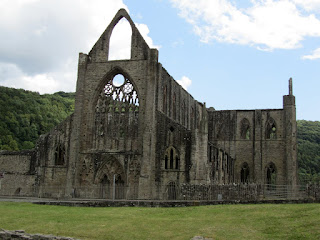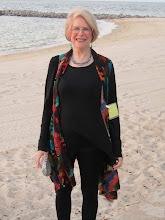We awoke to sunshine this morning, but we were both so tired that we got a late start. We were going to take a nice drive through the countryside and decided on Tintern Abbey.
"Tintern Abbey was founded by Walter de Clare, Lord of Chepstow, on 9 May 1131. It is situated in the village of Tintern, on the Welsh bank of the River Wye in Monmouthshire. It was only the second Cistercian foundation in Britain, and the first in Wales. It is one of the most spectacular ruins in the country and inspired the William Wordsworth poem "Lines Composed a Few Miles above Tintern Abbey".
The monks for Tintern came from a daughter house of Cîteaux, L'Aumône, in the diocese of Blois in France. The Cistercian monks (or White Monks) who lived at Tintern followed the Rule of St. Benedict. The Carta Caritatis (Charter of Love) laid out their basic principles, of obedience, poverty, chastity, silence, prayer, and work. With this austere way of life, the Cistercians were one of the most successful orders in the 12th and 13th centuries. The lands of the Abbey were divided into agricultural units or granges, on which local people worked and provided services such as smithies to the Abbey. Many endowments of land on both sides of the Wye were made to the Abbey.
The present-day remains of Tintern are a mixture of building works covering a 400-year .period between 1136 and 1536. Very little remains of the first buildings; a few sections of walling are incorporated into later buildings and the two recessed cupboards for books on the east of the cloisters are from this period. The church of that time was smaller than the present building and was slightly to the north.
During the 13th century, the Abbey was virtually rebuilt; first the cloisters and the domestic ranges, then finally the great church between 1269 and 1301. The first mass in the rebuilt presbytery was recorded to have taken place in 1288, and the building was consecrated in 1301, although building work continued for several decades. Roger Bigod, 5th Earl of Norfolk, the then lord of Chepstow, was a generous benefactor; his monumental undertaking was the rebuilding of the church. The Abbey put his coat of arms in the glass of its east window in gratitude to him.
It is this great church that we see today. It has a cruciform plan with an aisled nave; two chapels in each transept and a square ended aisled chancel. The Gothic church represents the architectural developments of its day in the contemporary Decorated style. The buildings are constructed in Old Red Sandstone, of colours varying from purple to buff and grey. The main church building is 72 metres long.
In 1326 King Edward II visited Tintern and spent two nights there. The Black Death swept the country in 1349 and it became impossible to attract new recruits for the lay brotherhood. Changes to the way the granges were tenanted out rather than worked by lay brothers show the difficulty Tintern was experiencing with labour shortages. In the early 15th century, Tintern was experiencing financial difficulties, due in part to the effects of the Welsh uprising under Owain Glyndŵr against the English kings, and Abbey properties were destroyed by the Welsh rebels. The closest battle to the Abbey was at Craig y Dorth near Monmouth, between Trellech and Mitchel Troy.
In the reign of King Henry VIII, traditional monastic life in England and Wales was brought to an abrupt end by his policy of establishing total control over the church, partly to take advantage of the considerable wealth of the monasteries. On September 3, 1536, Abbot Wyche surrendered Tintern Abbey to the King's visitors and ended a way of life which had lasted 400 years. The valuable articles from the Abbey were sent to the King's treasury, and Abbot Wyche was pensioned off. The building was granted to the then-lord of Chepstow, Henry Somerset, 2nd Earl of Worcester. Lead from the roof was sold, and the decay of the shell of the buildings began." Wikipedia.
The ruins are very dramatic. It always amazes me that the engineering skills it took to design and build these were available in the 12th century. We saw a sign posted that there would be Morris dancers in the afternoon so we decided to have some tea ( for me) and ale (for Ned). No sooner had the dancers arrived in period costume, the skies opened up. Oh well.
The rest of the afternoon was spent driving through the rain to Cheltenham, our next destination. I wanted to spend some time in the Cotswolds. Little did I expect to be seeing most of it through the car windows.
"Tintern Abbey was founded by Walter de Clare, Lord of Chepstow, on 9 May 1131. It is situated in the village of Tintern, on the Welsh bank of the River Wye in Monmouthshire. It was only the second Cistercian foundation in Britain, and the first in Wales. It is one of the most spectacular ruins in the country and inspired the William Wordsworth poem "Lines Composed a Few Miles above Tintern Abbey".
The monks for Tintern came from a daughter house of Cîteaux, L'Aumône, in the diocese of Blois in France. The Cistercian monks (or White Monks) who lived at Tintern followed the Rule of St. Benedict. The Carta Caritatis (Charter of Love) laid out their basic principles, of obedience, poverty, chastity, silence, prayer, and work. With this austere way of life, the Cistercians were one of the most successful orders in the 12th and 13th centuries. The lands of the Abbey were divided into agricultural units or granges, on which local people worked and provided services such as smithies to the Abbey. Many endowments of land on both sides of the Wye were made to the Abbey.
The present-day remains of Tintern are a mixture of building works covering a 400-year .period between 1136 and 1536. Very little remains of the first buildings; a few sections of walling are incorporated into later buildings and the two recessed cupboards for books on the east of the cloisters are from this period. The church of that time was smaller than the present building and was slightly to the north.
During the 13th century, the Abbey was virtually rebuilt; first the cloisters and the domestic ranges, then finally the great church between 1269 and 1301. The first mass in the rebuilt presbytery was recorded to have taken place in 1288, and the building was consecrated in 1301, although building work continued for several decades. Roger Bigod, 5th Earl of Norfolk, the then lord of Chepstow, was a generous benefactor; his monumental undertaking was the rebuilding of the church. The Abbey put his coat of arms in the glass of its east window in gratitude to him.
It is this great church that we see today. It has a cruciform plan with an aisled nave; two chapels in each transept and a square ended aisled chancel. The Gothic church represents the architectural developments of its day in the contemporary Decorated style. The buildings are constructed in Old Red Sandstone, of colours varying from purple to buff and grey. The main church building is 72 metres long.
In 1326 King Edward II visited Tintern and spent two nights there. The Black Death swept the country in 1349 and it became impossible to attract new recruits for the lay brotherhood. Changes to the way the granges were tenanted out rather than worked by lay brothers show the difficulty Tintern was experiencing with labour shortages. In the early 15th century, Tintern was experiencing financial difficulties, due in part to the effects of the Welsh uprising under Owain Glyndŵr against the English kings, and Abbey properties were destroyed by the Welsh rebels. The closest battle to the Abbey was at Craig y Dorth near Monmouth, between Trellech and Mitchel Troy.
In the reign of King Henry VIII, traditional monastic life in England and Wales was brought to an abrupt end by his policy of establishing total control over the church, partly to take advantage of the considerable wealth of the monasteries. On September 3, 1536, Abbot Wyche surrendered Tintern Abbey to the King's visitors and ended a way of life which had lasted 400 years. The valuable articles from the Abbey were sent to the King's treasury, and Abbot Wyche was pensioned off. The building was granted to the then-lord of Chepstow, Henry Somerset, 2nd Earl of Worcester. Lead from the roof was sold, and the decay of the shell of the buildings began." Wikipedia.
The ruins are very dramatic. It always amazes me that the engineering skills it took to design and build these were available in the 12th century. We saw a sign posted that there would be Morris dancers in the afternoon so we decided to have some tea ( for me) and ale (for Ned). No sooner had the dancers arrived in period costume, the skies opened up. Oh well.
The rest of the afternoon was spent driving through the rain to Cheltenham, our next destination. I wanted to spend some time in the Cotswolds. Little did I expect to be seeing most of it through the car windows.










No comments:
Post a Comment